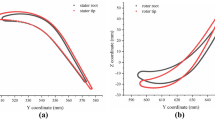Abstract
The fine structure of wind-wave spectra in a wind-wave tunnel is investigated in connection with the process of nonlinear interaction among spectral components, where each spectrum is calculated from about one hour of data measured with 8 wave gauges arranged at a distance of 25 cm. It is found that there are several significant spikes, or primary modes, around the spectral maximumf 0. Among such primary modes, three primary modes including the spectral maximum satisfy the resonance condition 2f 0=f 1+f 2, wheref 1 andf 2 are frequencies of the higher and lower frequency modes adjacent tof 0, while the frequency width between adjacent modes,f 1−f 0 orf 0−f 2, is nearly equal to 0.1f 0. In the process of growth of the spectra with fetch, the energy density at the lower frequencyf 2 increases accompanied with an energy decrease at the higher frequencyf 1, and the modef 2 replaces the modef 0 as the spectral maximum. This evolutional process is repeated several times in the range of the present experimental condition. These results suggest that the discrete primary modes are not due to statistical error, but rather due to some wave-wave interaction.
Similar content being viewed by others
References
Alber, I.E. (1978): The effects of randomness on the instability of two-dimensional surface wavetrains. Proc. Roy. Soc. Lond. A,363, 525–546.
Benjamin, T.B. and J.E. Feir (1967): The disintegration [of wave trains on deep water. Part 1. Theory. J. Fluid Mech.,27, 417–430.
Hamilton, J., W.H. Hui and H.A. Donelan (1979): A statistical model for groupiness in wind waves. J. Geophys. Res.,84, 4875–4884.
Hasselmann, K., T.B. Barnett, E. Bouws, H. Carlson, D.E. Cartwrite, K. Enke, J.A. Ewing, H. Gienapp, D.E. Hasselmann, P. Kruseman, A. Meerburg, P. Müller, D.J. Olber, K. Richter and W. Sell (1973): Measurements of wind-wave growth and swell decay during the Joint North Sea Wave Project (JONSWAP), Deut. Hydrogr. Z., Suppl. A,8, No. 12.
Hatori, M. (1984): Nonlinear properties of laboratory wind waves at energy containing frequencies. Part 1. Probability density distribution of surface elevation. J. Oceanogr. Soc. Japan.40, 1–11.
Kawai, S. (1979): Generation of initial wavelets by instability of a coupled shear flow and their evolution to wind waves. J. Fluid Mech.,93, 661–703.
Longuet-Higgins, M.S. (1962): Resonant interaction between two trains of gravity waves. J. Fluid Mech.,12, 321–332.
Mollo-Christensen, E. and A. Ramamonjiarisoa (1978): Modeling the presence of wave groups in a random wave field. J. Geophys. Res.,83, 4117–4122.
Phillips, O.M. (1960): On the dynamics of unsteady gravity waves of finite amplitude. Part 1. J. Fluid Mech.,9, 193–217.
Phillips, O.M. (1977): The dynamics of the upper ocean. 2nd ed., Cambridge Univ. Press, 336 pp.
Taira, K. (1972): A field study of the development of wind-waves. Part 1. The experiment. J. Oceanogr. Soc. Japan,28, 187–202.
Toba, Y. (1978): Stochastic form of the growth of wind waves in a single parameter representation with physical implication. J. Phys. Oceanogr.,8, 494–507.
Author information
Authors and Affiliations
Rights and permissions
About this article
Cite this article
Hatori, M. Nonlinear properties of laboratory wind waves at energy containing frequencies. Journal of the Oceanographical Society of Japan 40, 12–18 (1984). https://doi.org/10.1007/BF02071204
Received:
Revised:
Accepted:
Issue Date:
DOI: https://doi.org/10.1007/BF02071204




